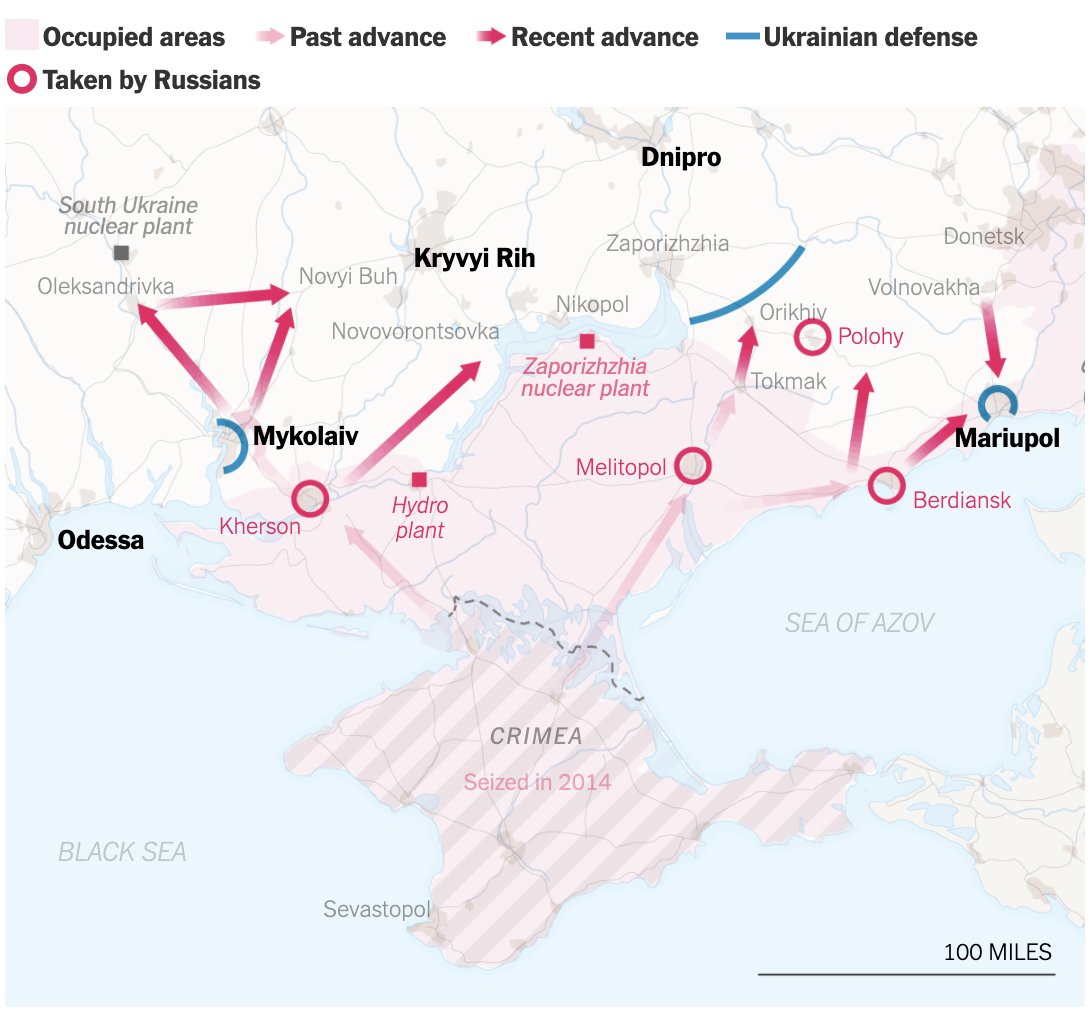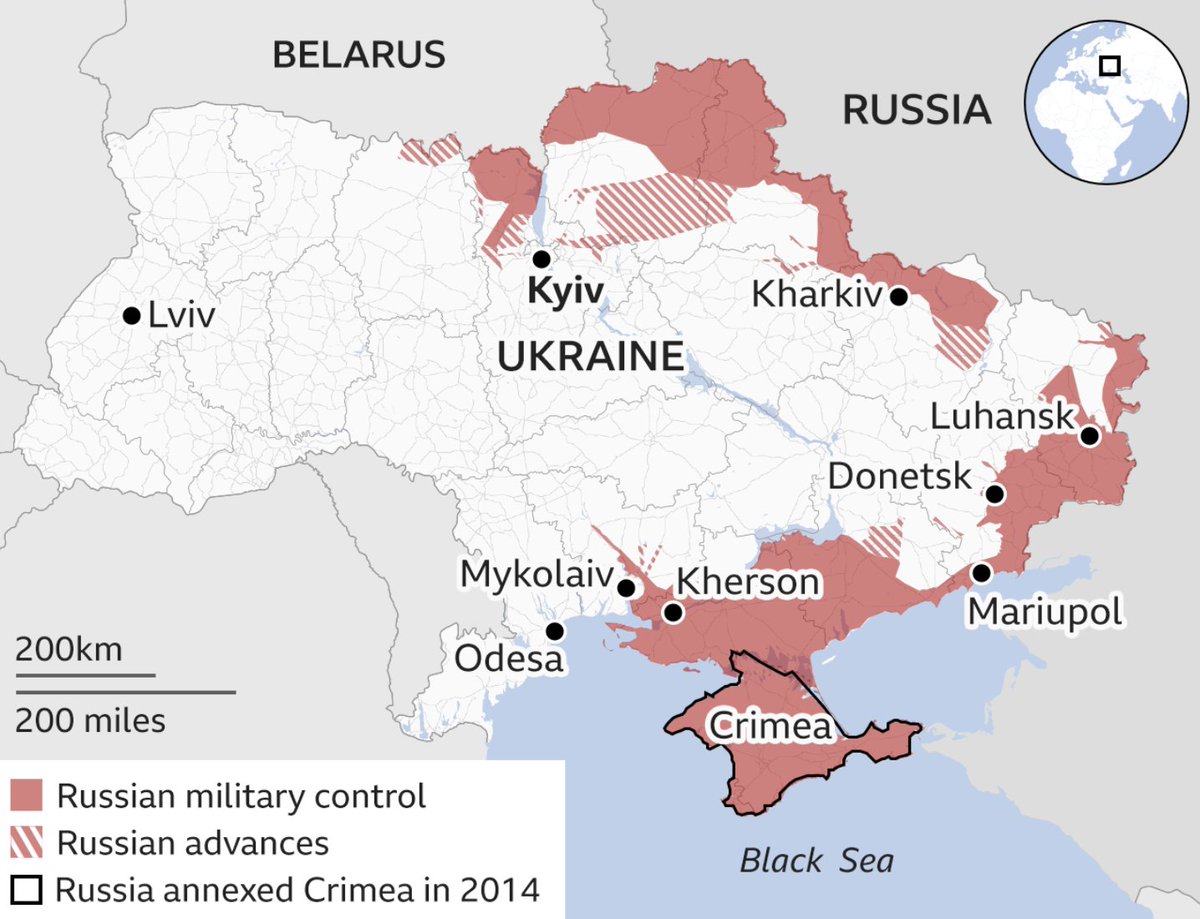
1) @nytimes continues to publish its excellent battle maps. This series focuses on 3 fronts: Kiev, Kharkiv, and the wider south. I will also look at the east/Donbas front. 

2) First, Kiev. Russian forces don't appear to have made major gains here, but appear to be positioning for an assault or siege of the capital. The mayor of Chernihiv said the city is now surrounded. Russian forces appear to be bypassing the city & are pushing southward to Kiev. 

3) Chernihiv province is close to being enveloped. The Russian column in the northeast that we've heard so much about is reported to be fanning out across the countryside & deploying artillery/rocket launchers that oriented at the capital.
bbc.com/news/world-eur…
bbc.com/news/world-eur…
4) Russian forces are not positioned to cut off Kiev from the south at this time. North & East of the capital, Russian forces continue to position to support the Kiev operation.
5) Ukrainian forces savaged a Russian armored unit in Brovary, just east of Kiev. It is unclear if this unit retreated or moved forward after the attack. But Russian forces are clearly due east of Kiev.
6) Ukrainian forces will continue to be able to reinforce Kiev if Russian troops cannot close the southern approach. 

7) East: Ukrainian forces continue to block the Russian attempts to take the city of Kharkiv. Russian troops appear to be attempting to encircle the city, advancing from the northeastern outskirts. East of Kharkiv, the Russians are advancing on Izium. 

8) The Russian push to Izium poses serious problems for Ukrainian troops holding the line in the Donbas region. The @nytimes maps shows Russian forces penetrating Ukrainian lines just north of Donetsk. If they can link up with Russian troops pressing on Izium ... 

9) ... then much of far eastern Ukraine & Ukrainian forces operating there will be cut off. Further west, the Russians launched their first airstrikes in Dnipro, indicating the city is now in the crosshairs. This is a linchpin city, its capture would be devastating for UKR.
10) In the south, the @nytimes map now shows the city of Polohy under Russian control. As noted in previous update, the Ukrainians have established a defensive line southeast of Zaporizhzhia, which is key to the defense of Dnipro. 

11) It is unclear if the Russians will try to punch through the Zaporizhzhia defensive line or outflank it from the east and further west. A western approach may prove difficult, with several major cities to overcome. Russian force do appear to be orienting towards Kryvyi Rih. 

12) Lack of reporting on the status of both Russian & Ukrainian forces in the south makes it difficult to determine what may happen. The Russian offensive in the south is ambitious, is there enough combat power to pull it off? Is Odesa or Zaporizhzhia/Dnipro the key objective?
13) Are there enough Ukrainian troops available to blunt/halt this ambitious offensive? What is the combat effectiveness of Ukrainian units in the south? There is seen anecdotal evidence that there are problems.
https://twitter.com/billroggio/status/1500915123023753218
14) The recent advances by the Russians in the south indicates that Zaporizhzhia/Dnipro and the South Ukraine nuclear plant appear to be the prime focus in the near term. If the Russians can take the South Ukraine plant and range to the Moldavian border, Odesa is cut off. 

15) A reminder that an operation of this scale was never doing to take days to complete. Stiff Ukrainian resistance has assured that. Keep in mind it took the U.S. military three weeks to reach Baghdad and 42 days to conquer Iraq.
16) The outcome is not assured, this is war and any number of factors can change the tide. At the moment the Russians have the initiative. It isn't pretty, the Russians have had their fair share of problems. But you can have tactical failures and still achieve strategic success.
• • •
Missing some Tweet in this thread? You can try to
force a refresh







